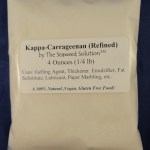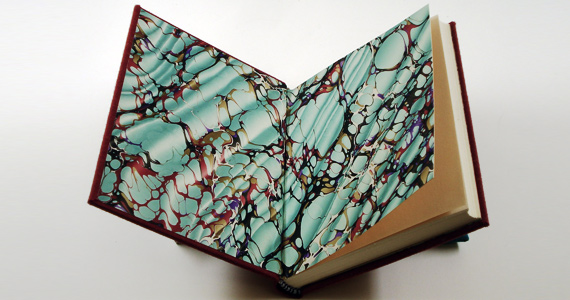Marbling Tutorials, Equipment & Photo Galleries

Marbling paper for book endsheets is a great way to add a little more class to your bookbinding project. Marbling is very simple to do and every print is completely different which further helps to add originality to your books. Your bookbinding marbling adventure doesn’t have to stop at endsheets, you could also experiment with marbling the coverboards, the book cover material or even the book block fore-edges.
For the general craft-worker or bookbinding hobbyist you’ll likely be able to complete adequate paper marbling with materials you can find at home or pick up from local stores (you can also buy marbling kits that have everything you need to get started). For those looking for a more professional finish you’ll be pleased to know that marbling is an art, and as such there are many techniques and concepts you can learn to make your books stand out from the rest. I would recommend checking our post on the Top 5 Must Read Books on Marbling Techniques + Reviews.
We also have our own tutorial for those starting to learn how to make marbled paper: Turkish Marbling Tips for Beginners.
History of Marbling

Marbling (or marbleizing as it was known at the time) was thought to have started in the 1100’s in either Turkey or Persia though many scholars believe that the suminagashi (or ‘floating ink‘) techniques that were developed in Japan during the 12th Century were in fact the foundations for paper marbling. The earliest marbled books that are still around today originate from Turkey, 15th century.
Outside of their decorative qualities, marbled papers were once used primarily to prevent erasure and forgery on the back of official documents.
The German Album Amicorum (an autograph book used by scholars and students) from 1604 is the earliest known example of European marbling.
Additional Resources
- History of Marbling on Wikipedia.com
- ‘Decorated Paper’ history of marbling from the University of Washington
- History of Suminagashi
- EBRU Marbling History
Paper Marbling Instructions & Tutorials
There are many different ways to marble paper and we’re going to cover a few of the most common marbling techniques below but first of all I think we should take a minute or two to watch some of the best marblers in the world… I hand-selected these videos and consider them to be the best examples of professional marbling I could find on the internet – the work produced is simply fantastic and well worth a watch, no one video is the same so take the time to watch a few of them before moving on!
Some of the Greatest Paper Marblers in the World?
Don't forget to subscribe to our YouTube channel to get access to HD videos of hundreds of Book Binding tutorials and reviews!
Turkish Marbling Tips for Beginners
 Many paper marbling video tutorials leave some very basic but important details obscure, or do not explain well. Luckily, we have our own post, that describes the things you need to know before beginning to make marbled paper.
Many paper marbling video tutorials leave some very basic but important details obscure, or do not explain well. Luckily, we have our own post, that describes the things you need to know before beginning to make marbled paper.
Many thanks to Crystal Shaulis, Intern Coordinator and an instructor at the Kalamazoo Book Arts Center, for writing that post for iBookBinding.
Check tutorial at iBookBinding
The Shaving Cream Method (Very Basic)
Perfect for children and small arts and crafts projects. Marbling with shaving cream can produce some good results but due to the process and the fact you have to scrape shaving cream and paint off the paper after you press it onto the ‘size’ means that you’re often left with undesirable results. Chemicals in the shaving cream are probably also not good for the paper so keep this one for the children. Good idea though none the less.
Watch tutorial on ArtfulParent.com
Spray Paint and Water Marbled Paper Method (Basic)
Another alternative way to create marbled effects on paper is to use spray paint and a bucket of water. Some excellent results can be had using this technique but due to the fact you’re using spraypaints instead of inks means you have to conduct this outside and also have to deal with the stiffness of the paper and paint cracking after the process is done.
Probably not suitable for 90% of bookbinding projects but worth knowing about and experimenting with incase the situation arises where you want to try something different. A good tutorial though with some lovely photos that is worth looking at.
Watch tutorial on AlisaBurke.blogspot.gr
Marbled Paper with Oil paints and Turpentine Method (Basic)
Now we’re starting to get more into the classic forms of marbling paper. This marbled paper tutorial uses oil paints mixed with turpentine to create some very vibrant marbled paper effects. I would normally steer clear of using this method on any bookbinding projects I truly valued (due to the terps and the fact that oil paints can get a bit tacky in hot weather) but great for a quick project or for an introduction into marbling.
The tutorial itself is very simple to follow.
Watch tutorial on RookieMag.com
Chalk and Water (Basic)
Don't forget to subscribe to our YouTube channel to get access to HD videos of hundreds of Book Binding tutorials and reviews!
Suminagashi (Japanese Ink & Water) (Intermediate)
Using sumi ink, water and dispersant to produce some beautiful traditional suminagashi artwork seems simple but it’s actually quite challenging to get the desired effects. I personally love this technique, it’s beautifully simple and the results you get can be fantastic.
Ruth Bleakley has a lovely small post on how best to fix problems you might be having with suminagashi which you might want to read through before starting.
View tutorial on RuthBleakley.com
Liquid Acrylics, Methylcellulose, Alum & Water Paper Marbling (Intermediate)
A great tutorial on paper marbling using liquid acrylics. This is the technique most people will probably be familiar with and whilst you can be quite creative it’s hard to become a master. Perfect for professional binding work as well as craft-work.
See the below Marbling Supplies section for advice on the best liquid acrylics to use with this technique.
View tutorial on MarthaStewart.com
[wysija_form id=”1″]
Marbling with Acrylic, Carrageenan, Alum (Advanced)
The full-blown marbling technique as adopted by the pro’s.
A great post by Henry Hebert on his time spent in his workshop with Regina and Dan from Chena River Marblers. Some of the work produced by Henry and his students are simply fantastic.
View Post on HenryHebert.wordpress.com
[support-website]Marbling Supplies, Tools & Equipment
Carrageenan

Carrageenan (pronounced ‘care-a-GHEE-nan’), is a type of gelatin used predominantly as a thickener in the food industry (you’ll likely find it in ice-cream, cottage cheese, chocolate milk etc) but is also a popular choice as a ‘size’ in professional marbling projects. nb, a ‘size’ in marbling is the solution on which the colours are floated.
- More info here: http://marbleart.us/CarrageenanInfo.htm
- Available on Amazon.com: http://ww.amazon.com/gp/product/B00E6P1JGE
Alum (aluminum sulphate)

Aluminium sulfate (alum) is used as a mordant in paper marbling to help fix paints or inks to the paper. It is normally applied via a sponge on paper and left to dry before using. You can purchase many papers specifically for marbling which have already been coated with alum or a similar mordant. If one is to use paper which has not already been treated with alum you will find most of the paint or ink will simply run off. Alum is also used in food processing and water purification and is none-toxic. Preparation of alum: (50 grams) of alum to 1 pint of water. I normally use Jacquard Alum for fine marbling works.
Marbling Gall

Marbling Gall or Ox-Gall is a surfactant or wetting agent, its primary purpose is to help colours float and spread out on the size. Ox-gall is made from the bile of an OX (yup!) but marbling gall’s can generally be made from the bile of any animal.
Colours range from dark brown to transparent but as you only add a couple of drops to some paints it doesn’t affect the colour. You will find that by using gall that your colours will never mix, this is what creates such sharp lines in professional marbling.
Ox-gall is an essential item to have in your marbling arsenal, find out more info on marbling gall here or check prices on amazon.com here.
Even more gall resources: marblingpaper.com | marbleart.us
Kodak Photo-Flo – Ox Gall Alternative

Available here on amazon.com, Kodak Photo-Flo acts as a cheaper alternative to Ox-Gall produces almost the same result but with noticeable differences, not recommended for professional works but always good to have on hand.
Gum Tragacanth

Gum Tragacanth-Tragacantha was used as marbling size from the inception of marbling to around the 19th century it was largely replaced by carrageenan. Today it is still used, especially in Turkey for ebru styles of marbling.
Gum Tragacanth is formed by the stem of certain plants belonging to the Astralagus Leguminosae family of plants and is sourced typically from Turkey, Iran and around certain areas of Afghanistan.
Check out prices here on amazon.com
Methylcellulose
Used as a marbling size. See our Bookbinding Glues post for info.
Marbling Tray
Pretty much any shallow flat tray is suitable for marbling.
Combs & Rakes
Various sizes and teeth spacings for different designs.

You can also make your own…
Acrylics and Paints

Here is a thorough review of different acrylic paints of different makes and price ranges by WonderStreet: http://wonderstreet.com/blog/choosing-the-acrylic-paint-thats-best-for-you. Hope it would help you to choose the paint that suits you both in price and quality.
I’ve had best results using liquid acrylic paints/inks but know many that use sumi ink, watercolors, diluted acrylic paint and even oils. Experiment and see what works for you.
Other Recommended Marbling Inks
Marbled Paper Examples

Make sure to check this awesome marbling gallery on Pinterest!
And Gerry’s Comprehensive Marbleart.us site
Also Oguz Uygur’s Gallery
Below Photos by Lili’s Bookbinding Blog
http://lilbookbinder.wordpress.com/marbled-paper/
Suminagashi
*suminagashi, which means “floating ink” in Japanese is the oldest method of decorative paper made with floating colors that is known today…
Don't forget to subscribe to our YouTube channel to get access to HD videos of hundreds of Book Binding tutorials and reviews!
Additional Resources
Vintage Marbled Paper Designs
More info at http://bibliodyssey.blogspot.co.uk/2010/11/marbled-paper-designs.html
Photos taken from University of Washing ‘Decorated and Decorative Paper Collection’
Further Reading
- Paper Marbling: Turkish Marbling Tips for Beginners
- Top image credit: Henry Hebert
Please Support us on Patreon!


Moreover, starting with the pledge level of $3, you will get a digitized vintage book about bookbinding, book history, or book arts each month from us!
These pledges help iBookBinding to continue its work and bring more information about bookbinding and book arts to you!

















































